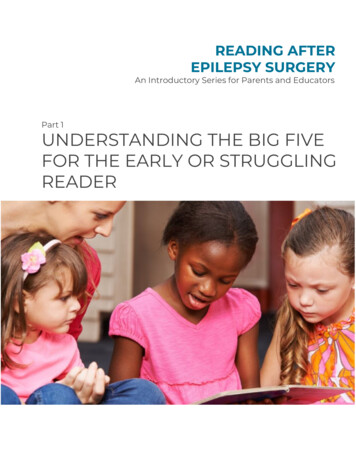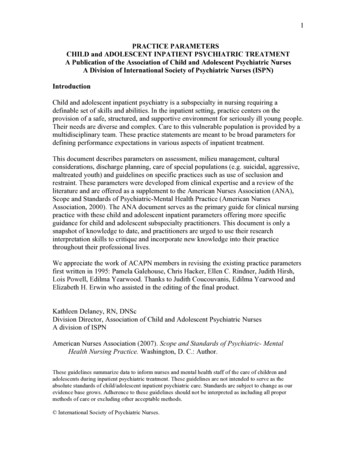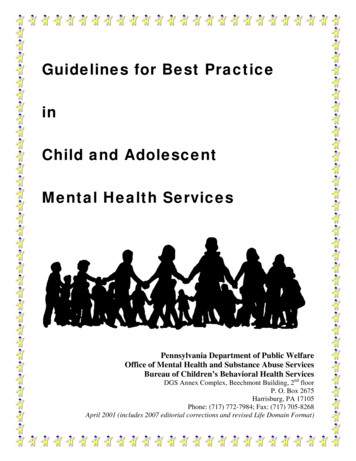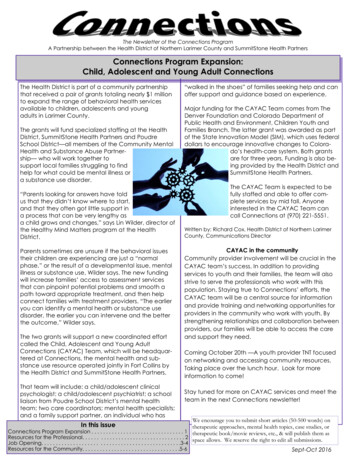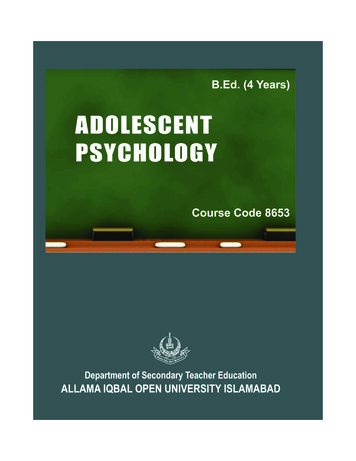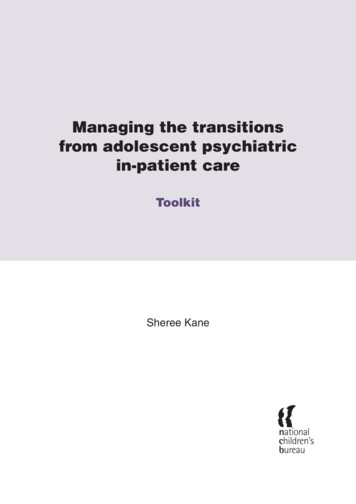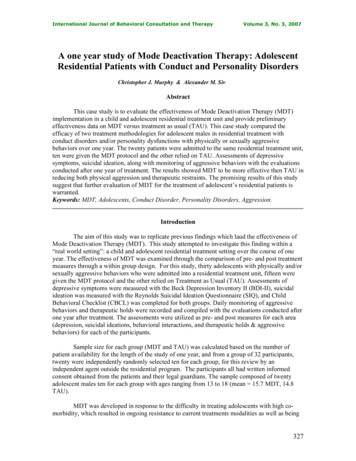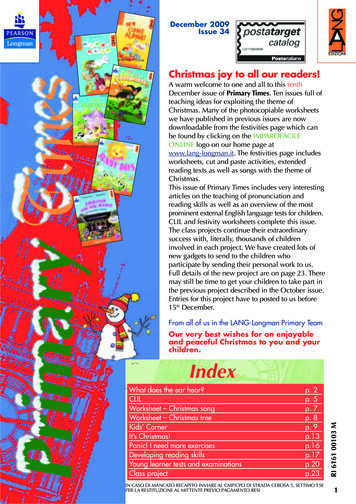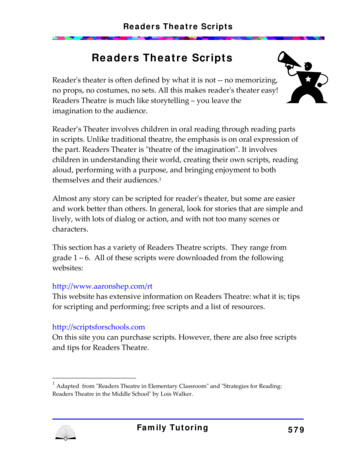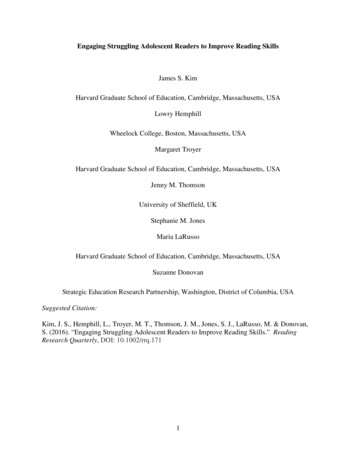
Transcription
Engaging Struggling Adolescent Readers to Improve Reading SkillsJames S. KimHarvard Graduate School of Education, Cambridge, Massachusetts, USALowry HemphillWheelock College, Boston, Massachusetts, USAMargaret TroyerHarvard Graduate School of Education, Cambridge, Massachusetts, USAJenny M. ThomsonUniversity of Sheffield, UKStephanie M. JonesMaria LaRussoHarvard Graduate School of Education, Cambridge, Massachusetts, USASuzanne DonovanStrategic Education Research Partnership, Washington, District of Columbia, USASuggested Citation:Kim, J. S., Hemphill, L., Troyer, M. T., Thomson, J. M., Jones, S. J., LaRusso, M. & Donovan,S. (2016). “Engaging Struggling Adolescent Readers to Improve Reading Skills.” ReadingResearch Quarterly, DOI: 10.1002/rrq.1711
ABSTRACTThis study examined the efficacy of a supplemental, multicomponent adolescent readingintervention for middle school students who scored below proficient on a state literacyassessment. Using a within-school experimental design, the authors randomly assigned 483students in grades 6–8 to a business-as-usual control condition or to the Strategic AdolescentReading Intervention (STARI), a supplemental reading program involving instruction to supportword-reading skills, fluency, vocabulary, and comprehension, and peer talk to promote readingengagement and comprehension. The authors assessed behavioral engagement by measuring howmuch of the STARI curricular activities students completed during an academic school year, andcollected intervention teachers’ ratings of their students’ reading engagement. STARI studentsoutperformed control students on measures of word recognition (Cohen’s d 0.20), efficiency ofbasic reading comprehension (Cohen’s d 0.21), and morphological awareness (Cohen’sd 0.18). Reading engagement in its behavioral form, as measured by students’ participation andinvolvement in the STARI curriculum, mediated the treatment effects on each of these threeposttest outcomes. Intervention teachers’ ratings of their students’ emotional and cognitiveengagement explained unique variance on reading posttests. Findings from this study support thehypothesis that (a) behavioral engagement fosters struggling adolescents’ reading growth, and(b) teachers’ perceptions of their students’ emotional and cognitive engagement furthercontribute to reading competence.2
The roughly one quarter of U.S. eighth graders who score below basic on nationalassessments of reading (National Center for Education Statistics, 2015) struggle with the readingdemands of secondary school. They are challenged by expectations that they summarizetextbook passages, use context to determine word meaning, and make text-based inferences. Formany adolescents with reading difficulties, gaps in decoding and fluency compromise basiccomprehension (Catts, Compton, Tomblin, & Bridges, 2012; Schatschneider, Fletcher, Francis,Carlson, & Foorman, 2004; Verhoeven & van Leeuwe, 2008). As a consequence, adolescentreading interventions often target word- and sentence-level skills in addition to skills related tomeaning construction. Despite calls for increased attention to the needs of struggling adolescentreaders (Biancarosa & Snow, 2004; Kamil et al., 2008), however, the impacts of existingmulticomponent interventions have often been modest, especially when moved to scale in lowperforming schools and with teacher, rather than researcher, implementation (Edmonds et al.,2009; Scammacca et al., 2007; Solis, Miciak, Vaughn, & Fletcher, 2014; Wanzek et al., 2013).Student motivation and engagement are frequently cited as barriers to the success ofadolescent literacy interventions (Kamil et al., 2008; Manset-Williamson & Nelson, 2005;O’Brien, Beach, & Scharber, 2007; Solis et al., 2014), but specific strategies to foster motivationand reading engagement have rarely been central to intervention design. Although there areengagement-focused approaches to adolescent literacy instruction (e.g., Applebee, Langer,Nystrand, & Gamoran, 2003; Greenleaf & Hinchman, 2009; Guthrie, McRae, & Klauda, 2007),involving peer talk about text and exploration of text meaning and value, struggling readers alsoneed instruction in word- and sentence-level processes that underlie skilled reading.Multicomponent reading interventions often include isolated practice on basic reading skills butrarely embed basic skills work in more cognitively challenging and engaging literacy activities.3
As a consequence, students may fail to see the relevance of skills work and may lack adequateopportunities for applying new skills in meaningful and cognitively demanding contexts.Theoretical Foundations for the Strategic Adolescent Reading Intervention (STARI)This study reports on the impacts of a new approach to intervention for adolescents with readingdifficulties, the STARI. The intervention program addresses components essential for skilledreading (e.g., decoding, fluency) while also teaching meaning-making strategies important forliteral and deep comprehension. Figure 1 displays our model of how STARI is designed topromote engaged reading and subsequent growth in reading skills. Our model draws on andadapts the engagement framework presented by Guthrie, Wigfield, and You (2012).Given the limited effectiveness of many existing interventions, we designed a programthat would connect reluctant readers with cognitively challenging texts and activities whilesimultaneously developing basic reading skills. With student motivation at the center of concernsabout the efficacy of adolescent reading interventions, we planned intervention activities thatreflect research on student motivation and directly examined the contribution of studentengagement when investigating program impacts on reading skills.Growth in Reading Skills in AdolescenceBy early adolescence, successful comprehension requires the integration of multiplelinguistic and cognitive processes (Cain & Oakhill, 2012; Cromley & Azevedo, 2007). Adequateskills in decoding, morphosyntax, and sentence structure are critical for making meaning fromtext. To understand a class reading in humanities, for example, students first need to confidentlydecode both higher and lower frequency words and parse academic sentence structures (Fang,Schleppegrell, & Cox, 2006). Morphological analysis skills, such as the ability to recognizeadjectival and nominalizing suffixes, are important for assigning syntactic roles to keywords, a4
process that affects readers’ ability to extract literal propositions from the text and construct acomprehensive textbase (van Dijk & Kintsch, 1983). As readers produce a situation model(Kintsch, 1998; Zwaan & Radvansky, 1998), they integrate background knowledge with theliteral textbase (Graesser & McNamara, 2011; Zwaan, 1994). All of these processes arevulnerable for adolescents with gaps in basic reading skills (Brasseur-Hock, Hock, Kieffer,Biancarosa, & Deshler, 2011; Cirino et al., 2013).Improvements in reading subskills, however, are not sufficient for deep comprehension.Effective intervention needs to expose adolescents to texts and reading tasks that are complexand open-ended enough to support sophisticated reasoning. With a few exceptions (e.g., ReadingApprenticeship and Adolescent Literacy; Greenleaf & Hinchman, 2009), interventions forstruggling readers present students with simplified texts and routine tasks (Compton, Miller,Elleman, & Steacy, 2014; O’Brien et al., 2007). In Wilson Just Words, for example, studentspractice decoding and writing dictated nonsense words. Connected texts used for readingpractice are brief and designed to highlight particular spelling patterns. In most interventionprograms, component skills are practiced in isolation, without applications to challenging andmotivating content. Adolescents receiving reading intervention are infrequently asked to engagein the kind of independent meaning construction with complex text that typifies skilled reading.Engaged Reading and the Design of STARIReading motivation refers to an individual’s values, beliefs, attitudes, and goals related toreading (Conradi, Jang, & McKenna, 2014; Guthrie & Wigfield, 2000; Unrau & Quirk, 2014).Reading motivation declines markedly as students move through the early years of schooling andinto adolescence (McKenna, Kear, & Ellsworth, 1995; Unrau & Schlackman, 2006), a patternthat particularly affects boys (De Naeghel et al., 2014; Jacobs, Lanza, Osgood, Eccles, &5
Wigfield, 2002; Kelley & Decker, 2009; McGeown, Duncan, Griffiths, & Stothard, 2015),students from low-income families (Guo, Sun, Breit-Smith, Morrison, & Connor, 2015) andAfrican American and Latino students (Guthrie, Coddington, & Wigfield, 2009; Guthrie &McRae, 2012; Ryan & Deci, 2000a, 2000b). In programs for adolescents with readingdifficulties, weak motivation is often seen as a barrier to engaging participants in activities thathave the potential to improve reading skills (Kamil et al., 2008; Solis et al., 2014).Research on Concept-Oriented Reading Instruction (CORI), however, has documentedkey features of reading programs that can support motivation. These include relevance (i.e.,topics and texts that connect to students’ lives; Guthrie, 2004; Guthrie, Klauda, & Ho, 2013),integration of skills and content through a thematically organized curriculum, experiences ofsuccess through accessible text and increasing independence in skills application, andcollaboration (i.e., opportunities for students to work together on meaning construction; Guthrie,2008; Guthrie et al., 2007; Guthrie & Klauda, 2014). CORI program characteristics that buildmotivation, not always present in traditional remedial programs, directly influence the design ofSTARI. Figure 1 illustrates the motivation-enhancing features of STARI and the pathwaythrough which these features are theorized to promote reading engagement and, in turn, growthin reading skills.Engaging and Accessible TextsThe interest level of the texts that students read has been demonstrated to affect bothreading engagement and reading comprehension (Ainley, Hidi, & Berndorff, 2002; McGeown etal., 2015; Oakhill & Petrides, 2007). Text features associated with higher reader interest includeimportance/value, personal relevance, and novelty (Ivey & Broaddus, 2001; Tatum, 2006; Wade,Buxton, & Kelly, 1999), characteristics that are also associated with better recall of key text6
propositions (Clinton & van den Broek, 2012; Flowerday & Shell, 2015). In selecting novels andnonfiction books for STARI, personal relevance and interest to young adolescents, textcharacteristics associated with reading engagement, were assessed through pilot work usingpotential texts in book groups involving students not participating in the study.Text accessibility, defined as text that is well matched with students’ current readingabilities, also affects reading engagement. In an experimental context, adolescents presented withtexts at their instructional level reported significantly higher engagement and interest than whenreading texts whose challenge level exceeded their reading ability (Fulmer & Tulis, 2013).Expectancy–value theory (Wigfield & Eccles, 2000) posits that students are more motivated toengage in a task such as reading when they see themselves as competent. Thus, texts that areaccessible are likely to promote greater feelings of self-efficacy, especially for adolescents withreading difficulties, who generally report lower levels of perceived competency when readinggrade-level text (Klauda, Wigfield, & Cambria, 2012; Wolters, Denton, York, & Francis, 2014).In addition to the impact of text characteristics, reader motivation is affected by broaderfeatures of instructional design (Hidi & Renninger, 2006; Paige, 2011; Schraw & Dennison,1994), such as the reading topics and tasks that are set for students and classroom participationstructures.Relevance/Importance and IntegrationSTARI is organized into a series of thematic units chosen to be not only interesting butalso of relevance and importance in young adolescents’ lives. In an influential study by Assor,Kaplan, and Roth (2002), teacher behaviors that demonstrated the relevance of academic topicsto students’ lives were important in promoting student engagement with schoolwork. STARItopics that reflect students’ cultural and personal identities, such as the Harlem Renaissance, the7
immigration debate, or nontraditional families, communicate to students that the curriculum isnot generic but personalized, designed to be relevant for them (Tatum, 2006). Intrinsicmotivation, an important determinant of both reading engagement and growth in reading skills, issupported when students read with interest and curiosity (Schiefele, Schaffner, Möller, &Wigfield, 2012).In contrast to the isolated skills practice that often characterizes remedial readingcurricula, STARI directly links work on component skills—decoding, fluency, andmorphological analysis—with cognitively challenging unit themes. The integration of basicskills activities with demanding, highly relevant content demonstrates for students the ways thatcomponent reading skills provide access to topics of value and importance (Guthrie et al., 2009).To promote interest and engagement, decoding and morphological analysis strategies weretaught with words connected to STARI unit themes. For example, in STARI Unit 2.2 on theSeptember 11 attacks and the Iraq War, students applied syllable division rules to collapse,accuse, and Saddam. Students then practiced reading words with the newly taught patterns inengaging nonfiction texts about the aftermath of September 11.Peer Collaboration and VoiceFinally, STARI was designed to promote social interactions that foster studentengagement. STARI uses four types of peer collaboration: partner-assisted fluency practice,reciprocal teaching of comprehension strategies, partner reading and responding to novels andnonfiction texts, and peer debate, in which teams gather text evidence and build arguments.Whereas peer-assisted learning has well-documented benefits for reading skill development (e.g.,Fuchs et al., 2001; Spörer & Brunstein, 2009), peer reading contexts may impact achievement inpart through increasing reading motivation. When students collaborate with peers on academic8
tasks, they come to feel a greater sense of relatedness, which can act as a motivational resourcein sustaining effort in the face of challenge (Furrer & Skinner, 2003). Attitudes toward readingoften become more positive after peer-assisted learning activities because students experiencegreater social support for learning (Kim, Linan-Thompson, & Misquitta, 2012). In addition, peercontexts in STARI encourage students to articulate personal stances on a text and then comparetheir stances with those of partners or classmates. Presenting and discussing individual reactionsto text is a practice that reflects reader response theories of sensemaking (Rosenblatt, 1978). Indoing so, students experience a positive sense of autonomy in meaning production, which canovercome passivity and support feelings of competence (Ryan & Deci, 2000a).Reading Engagement Fosters Reading SkillA central theoretical rationale for STARI is that reading engagement contributes togrowth in students’ reading skills (Guthrie et al., 2012; Guthrie & Klauda, 2014). The constructof engagement has been defined as “involvement, participation, and commitment to some set ofactivities” (Guthrie et al., 2012, p. 601). Engaged reading incorporates behavioral, emotional,and cognitive processes (Fredricks, Blumenfeld, & Paris, 2004; Unrau & Quirk, 2014), such asreading involvement, interest, and active problem solving. In addition, recent research hassuggested that “agentic engagement,” such as “students’ constructive contribution into the flowof organized discussion,” may also contribute to student achievement (Reeve & Tseng, 2011, p.258; see also Reeve, 2013). There is growing evidence that reading engagement is a keymechanism underlying the effects of innovative reading programs. Research on CORI, a programwith features that support motivation, engagement, and strategy use, has indicated that readingimprovement in CORI is largely mediated through gains in participants’ reading engagement(Guthrie, et al., 2007; Taboada, Tonks, Wigfield, & Guthrie, 2009; Wigfield et al., 2008).9
In Figure 1, drawing on a framework proposed by Guthrie and collaborators (2012), wehypothesize that students’ behavioral engagement—that is, their observed involvement andparticipation in literacy activities—directly impacts growth in reading skills. Measures ofbehavioral engagement have included observations of student effort, attention, and persistence inacademic tasks, as well as teacher and student self-reports of effort and task persistence (Guo,Connor, Tompkins, & Morrison, 2011; Guthrie, Wigfield, Metsala, & Cox, 1999; Skinner,Kindermann, & Furrer, 2009). By elementary and middle school, students who exhibitbehavioral engagement in literacy activities are reading and responding to more text thanclassmates who are less engaged. Thus, behavioral engagement in reading results in greater textexposure, with demonstrated benefits for students’ efficiency of word reading, development ofacademic vocabulary, and confidence in deriving meaning from text (Mol & Bus, 2011;Schaffner, Schiefele, & Ulferts, 2013).Guthrie et al. (2012) reviewed studies that revealed significant associations among avariety of measures of reading engagement and reading skill. Behavioral engagement measureshave typically included quantitative indicators of observable actions (e.g., time spent reading,involvement in literacy activities). However, as Unrau and Quirk (2014) argued, “appearingengaged does not guarantee that a student is actually engaged” (p. 266), underscoring theimportance of using more direct assessments of student engagement during academic learningtime.For adolescents, behavioral engagement is likely to lead to greater reading competence ifstudents are not merely reading but also participating in literacy activities that contribute to betterunderstandings of text. Behavioral engagement in STARI was assessed through individuals’ ratesof completion of STARI workbook activities. Most workbook activities in STARI require10
students to first read specific pages of unit novels or nonfiction and then form coherentrepresentations (Rapp & van den Broek, 2005), recording workbook responses that documenttheir understandings. STARI workbook activities focus student attention on key content in thetexts read, such as emerging character traits or important nonfiction concepts, often through textfocused discussion with a partner. Representative STARI workbook pages, demonstrating thetypes of literacy activities that students routinely engaged in, are shown in Figures 2 and 3. Wetheorize that STARI workbook completion, our measure of behavioral engagement, drivesimprovement in reading skills through the combined impacts of practice with component skills(e.g., morphological analysis), text exposure, and experience with content-focused interactionswith text (Goldman & Snow, 2015; McKeown, Beck, & Blake, 2009).Given that engagement incorporates multiple dimensions, research should ideally capturethe range of dimensions that are relevant to academic success (Sinatra, Heddy, & Lombardi,2015). For reading, there are clearly aspects of students’ emotional and cognitive engagementthat contribute to and extend the impacts of behavioral engagement. Most important, theseinclude enjoyment and interest in reading and active problem solving while reading (Schiefele etal., 2012). The Reading Engagement Index–Revised (REIR; Wigfield et al., 2008) measuresemotional and cognitive dimensions of engagement through teacher ratings, complementingmore direct measures of students’ behavioral engagement (Fredricks & McColskey, 2012). Thus,in addition to examining whether student behavioral engagement contributes to growth inreading, we collected intervention teachers’ reports of their students’ emotional and cognitiveengagement in literacy on the REIR and explored whether these dimensions of studentengagement added to our ability to predict reading gains.11
Finally, observations of STARI classrooms by research assistants enabled us tocharacterize overall levels of participant responsiveness, such as the degree to which studentsasked and answered peer and teacher questions, consistent with a broad conceptualization ofbehavioral engagement.Research Aims and HypothesesMany correlational studies have explored the complex interrelationships among readingpractices, student motivation, engagement, and reading skills. In this experimental study,however, we assessed the impact of a yearlong, engagement-oriented intervention on multiplereading skills, examining the mediating effect of students’ behavioral engagement on readingskills, and the contribution of teachers’ perceptions of students’ emotional and cognitiveengagement to reading gains. Our intervention and research design address two of the centralgaps in the reading engagement literature: the absence of experimental approaches to investigatepotential impacts of reading engagement on growth in reading skills, and limited researchfocused on students from low-income families, students of color, and struggling readers (Guthrieet al., 2012).Our analyses addressed three research questions:1. What is the intent-to-treat (ITT) estimate of STARI on multiple dimensions of readingskill for struggling readers in grades 6–8? Using ordinary least squares regressionanalysis, we examined whether students assigned to STARI performed better than controlgroup students on multiple dimensions of reading skill.2. Do levels of students’ behavioral engagement in STARI mediate improvement inreading skill? Using instrumental variables analysis, we examined whether students’12
participation and involvement in STARI literacy activities mediated improvement onmultiple dimensions of reading skill.3. Do levels of teachers’ ratings of student engagement among STARI students explainunique variance in posttests? We tested whether teacher ratings of engaged reading alsopredicted posttest reading scores among STARI students, controlling for the effects ofstudents’ prior reading skill and school quality.MethodContext for the StudyFour school districts in the Northeastern United States served as research sites: two largeurban districts and two rural/suburban districts. Our goal was to recruit a district sample thatrepresented a range of settings for implementing the reading intervention, although all of theparticipating sites were Title I schools, reflecting moderate to high levels of family poverty.Districts volunteered to be part of the study and solicited schools to participate (in the case of thelarger districts) or had all of their middle schools participate in the two smaller districts. Schoolshad moderate to high poverty levels, based on the percentage of students eligible for free orreduced-price lunch (49–90%).Sampling and RandomizationIn each of the eight participating middle schools, students scoring below proficient on thespring 2013 Massachusetts Comprehensive Assessment System English language artsassessment were eligible to participate in the study. Eligible students scored at or below the 30thpercentile for all test takers in the state. Students in substantially separate special educationclasses, students who were level 1 or 2 English learners, and students whose special education13
plan required an intensive, rules-based phonics intervention were excluded from studyparticipation.We used a randomized treatment–control, pretest–posttest design to address our primaryquestions. After identifying students comprising the target population for STARI, we assignedeach eligible student a random number and assigned students into the available seats inintervention classrooms following their rank orders. In essence, this within-school lotteryprocedure is equivalent to random assignment because student assignment to STARI or controlclassrooms was based on the random lottery number. We checked the fidelity of placement intoSTARI and control classrooms by conducting on-site visits in the fall, winter, and spring of the2013–2014 school year and confirmed that students were in the classrooms based on our randomassignment protocol. This randomization procedure has been successfully implemented inmiddle schools in which the number of struggling adolescent readers needing supplementalinstruction exceeds the number of available spaces in intervention classes (Cantrell, Almasi,Carter, Rintamaa, & Madden, 2010).Participating Students and TeachersAs illustrated in Table 1, STARI served a racially and linguistically diverse studentpopulation with moderate to high poverty levels, based on student eligibility for free or reducedprice lunch. There were no statistically significant differences by condition for student-leveldemographic variables, including free or reduced-price lunch status, English learner status, andspecial education status (all ps .05). Information on the number of eligible students, theselection probabilities, and the resulting intervention and control sample sizes is presented inTable 2. The number of eligible students and available slots in each intervention classroomvaried across schools.14
Certified teachers were recruited from participating schools to implement STARIinstruction. The 12 STARI teachers’ experience ranged from six to 35 years, with a mean of16.18 years (standard deviation [SD] 7.78 years). One had attained only a bachelor’s degree,10 had a master’s degree, and one had a doctorate. All 12 teachers were female, and nine wereEuropean American, with one African American, one Latina, and one Native American. All werefully qualified in the area of their main teaching assignments, which included reading, middleschool English, and middle school special education.In the following section, we describe the business-as-usual (BAU) condition and thensummarize the procedures for implementing professional development activities and measuringfidelity of implementation.ProceduresThe BAU ConditionThe BAU condition varied across sites because schools implemented a variety ofsupplemental interventions for struggling readers. One of the complexities inherent in a field trialspanning eight schools and four districts is the variety of BAU approaches across sites. Seventypercent of students who were eligible for STARI but randomly assigned to the control condition(n 214) received an alternative literacy intervention. Schools in all four districts offeredteacher-developed reading or writing classes as one possible BAU condition; in two schools,these classes were taught by teachers who also taught STARI. Some schools offered externallydeveloped reading interventions as BAU, such as Wilson Just Words. We obtained courseschedules to code each student’s control class as nonacademic (e.g., physical education, art),general academic support (e.g., study skills), or alternative literacy intervention. Overall, thecontrol group students were assigned to an alternative literacy course (70%) and/or received15
some form of general academic support (30%) in the BAU condition (e.g., state test preparation,AVID). We used this information to examine whether treatment effects were moderated by thetype of BAU condition.Professional Development and CoachingTeachers were introduced to the program through a three-day summer institute thataddressed traits of struggling adolescent readers, STARI lessons on decoding and morphology,and STARI fluency routines, as well as key practices for guided reading and partner reading:preteaching vocabulary, setting an engaging purpose for reading, silent reading of chunks,interactive discussion, and encouragement of text-based reasoning.Teachers also received regular in-class guidance from one of three project literacycoaches. Coaches observed and offered feedback, modeled instructional strategies, and consultedthrough e-mail and telephone calls. In addition, STARI teachers met in district-basedprofessional learning communities to discuss implementation challenges and participated in threestatewide network meetings each year, focused on supporting student talk about text.Description of the STARI CurriculumStructure and ScopeStudents received STARI during an elective period or whole-school intervention period.The number of class periods per week for STARI ranged from three to five. STARI was taughtfor the entire school year.STARI was delivered as a series of thematic units, each organized around an essentialquestion, such as “How can we find a place where we really belong?” In Unit 2.2, students tracedthis question while reading Jacob Lawrence’s narrative of the Great Migration, first-personaccounts of race riots in Northern U.S. cities as the African American population grew, poems of16
the Harlem Renaissance, and fictionalized experiences of contemporary young people in theBronx borough of New York City, New York. Each unit included a central novel and one ormore full-length works of nonfiction. Unit topics, such as sports in society, the war in Iraq, andthe immigration debate, were designed to be of high interest, personally relevant to adolescents,and complex enough to support discussion and debate. For each unit, teachers received projectauthored student workbooks for fluency, decoding, and comprehension practice; unit novels andnonfiction books; slides; and detailed daily lesson plans. A lesson plan sample appears in Figure4, illustrating the types of scaffolds provided for teachers implementing the curriculum.Core novels in STARI were accessible, ranging from approximately 600 to 800 Lexiles indifficulty, to match the reading skills of middle school students who perform at or below the 35thpercentile (MetaMetrics, n.d.; Ste
Apr 05, 2016 · Reading Intervention (STARI), a supplemental reading program involving instruction to support word-reading skills, fluency, vocabulary, and comprehension, and peer talk to promote reading engagement and comprehension. Th
